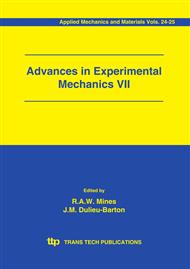p.201
p.207
p.213
p.221
p.227
p.233
p.239
p.245
p.253
Towards the Derivation of Stress Intensity Factors by Parametric Modelling of Full-Field Thermoelastic Data
Abstract:
Thermoelastic Stress Analysis (TSA) is a well-established full-field technique for experimental stress analysis that has proved to be extremely effective for studying stress fields in the vicinity of cracks. Recently, work has focused on the observation that the stress-sum contours (isopachics) obtained from TSA take the form of a cardioid. Genetic Algorithms (GAs) and Differential Evolution (DE) have proved successful for accurate parameter estimation of the cardioids, thus allowing the SIFs to be calculated. Originally, some curve-fits indicated that a pure cardioid form is inappropriate for the base model, especially for mixed-mode cracks. The deviation from the cardioid form has been shown to be due to higher-order terms within the stress function. The objective of the current paper is to use a modified version of the original methodology (that fitted parameters to a single isopachic) to find the higher-order parameters from the entire data field obtained from the TSA.
Info:
Periodical:
Pages:
227-232
Citation:
Online since:
June 2010
Authors:
Permissions:
Share:
Citation:


